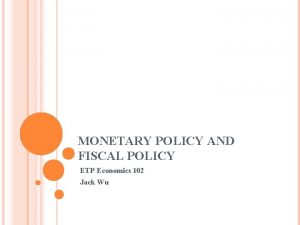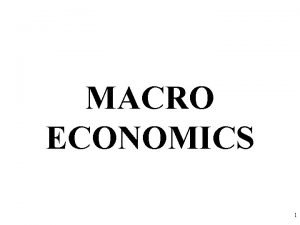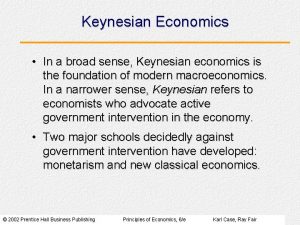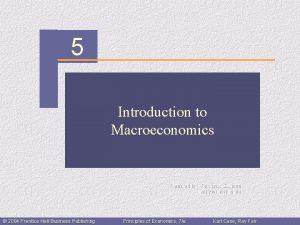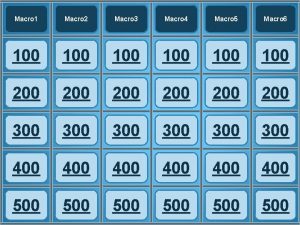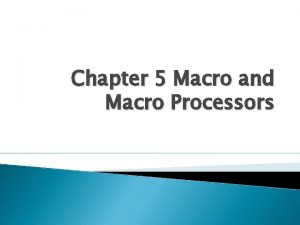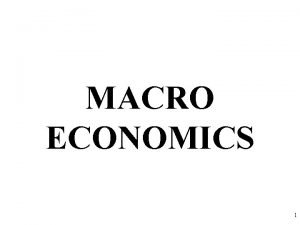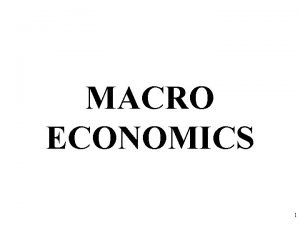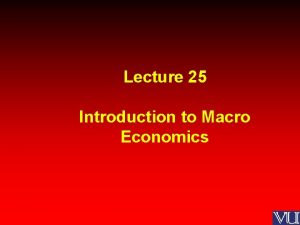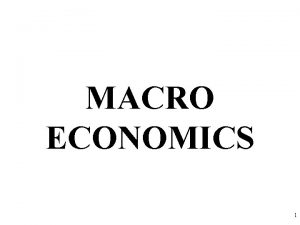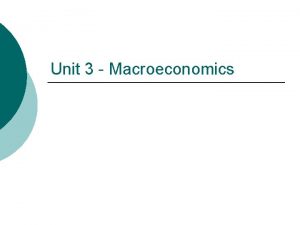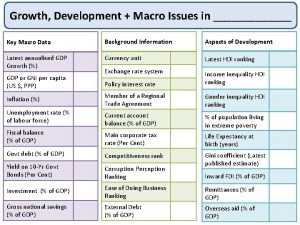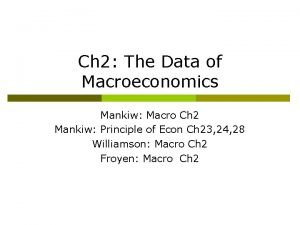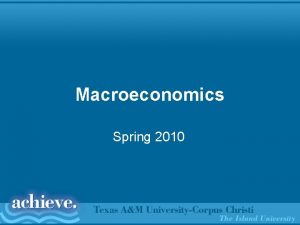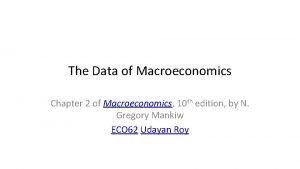macro CHAPTER TWO The Data of Macroeconomics macroeconomics











![Investment (I) def 1: spending on [the factor of production] capital. def 2: spending Investment (I) def 1: spending on [the factor of production] capital. def 2: spending](https://slidetodoc.com/presentation_image_h2/d75193828241e32b3a34c5c9f57b7cc4/image-12.jpg)





















































- Slides: 65

macro CHAPTER TWO The Data of Macroeconomics macroeconomics fifth edition N. Gregory Mankiw Power. Point® Slides by Ron Cronovich © 2002 Worth Publishers, all rights reserved

Learning objectives In this chapter, you will learn about: § Gross Domestic Product (GDP) § the Consumer Price Index (CPI) § the Unemployment Rate CHAPTER 2 The Data of Macroeconomics slide 1

Gross Domestic Product Two definitions: 1. Total expenditure on domestically-produced final goods and services 2. Total income earned by domestically-located factors of production CHAPTER 2 The Data of Macroeconomics slide 2

Why expenditure = income In every transaction, the buyer’s expenditure becomes the seller’s income. Thus, the sum of all expenditure equals the sum of all income. CHAPTER 2 The Data of Macroeconomics slide 3

The Circular Flow CHAPTER 2 The Data of Macroeconomics slide 4

Value added definition: A firm’s value added is the value of its output minus the value of the intermediate goods the firm used to produce that output. CHAPTER 2 The Data of Macroeconomics slide 5

Exercise: (Problem 2, p. 38) § A farmer grows a bushel of wheat and sells it to a miller for $1. 00. § The miller turns the wheat into flour and sells it to a baker for $3. 00. § The baker uses the flour to make a loaf of bread and sells it to an engineer for $6. 00. § The engineer eats the bread. Compute – value added at each stage of production – GDP CHAPTER 2 The Data of Macroeconomics slide 6

Final goods, value added, and GDP § GDP = value of final goods produced = sum of value added at all stages of production § The value of the final goods already includes the value of the intermediate goods, so including intermediate goods in GDP would be double-counting. CHAPTER 2 The Data of Macroeconomics slide 7

The expenditure components of GDP • consumption • investment • government spending • net exports CHAPTER 2 The Data of Macroeconomics slide 8

Consumption (C) def: the value of all goods • durable goods last a long time and services bought by ex: cars, home households. Includes: appliances • non-durable goods last a short time ex: food, clothing • services work done for consumers ex: dry cleaning, air travel. CHAPTER 2 The Data of Macroeconomics slide 9

U. S. Consumption, 2001 CHAPTER 2 The Data of Macroeconomics slide 10
![Investment I def 1 spending on the factor of production capital def 2 spending Investment (I) def 1: spending on [the factor of production] capital. def 2: spending](https://slidetodoc.com/presentation_image_h2/d75193828241e32b3a34c5c9f57b7cc4/image-12.jpg)
Investment (I) def 1: spending on [the factor of production] capital. def 2: spending on goods bought for future use. Includes: § business fixed investment spending on plant and equipment that firms will use to produce other goods & services § residential fixed investment spending on housing units by consumers and landlords § inventory investment the change in the value of all firms’ inventories CHAPTER 2 The Data of Macroeconomics slide 11

U. S. Investment, 2001 CHAPTER 2 The Data of Macroeconomics slide 12

Investment vs. Capital § Capital is one of the factors of production. At any given moment, the economy has a certain overall stock of capital. § Investment is spending on new capital. CHAPTER 2 The Data of Macroeconomics slide 13

Stocks vs. Flows Stock Flow More examples: stock flow a person’s wealth a person’s saving # of people with college degrees # of new college graduates the govt. debt the govt. budget deficit CHAPTER 2 The Data of Macroeconomics slide 14

Government spending (G) § G includes all government spending on goods and services. § G excludes transfer payments (e. g. unemployment insurance payments), because they do not represent spending on goods and services. CHAPTER 2 The Data of Macroeconomics slide 15

Government spending, 2001 CHAPTER 2 The Data of Macroeconomics slide 16

Net exports (NX = EX - IM) def: the value of total exports (EX) minus the value of total imports (IM) CHAPTER 2 The Data of Macroeconomics slide 17

An important identity Y = C + I + G + NX where Y = GDP = the value of total output C + I + G + NX = aggregate expenditure CHAPTER 2 The Data of Macroeconomics slide 18

A question for you: Suppose a firm § produces $10 million worth of final goods § but only sells $9 million worth. Does this violate the expenditure = output identity? CHAPTER 2 The Data of Macroeconomics slide 19

Why output = expenditure § Unsold output goes into inventory, and is counted as “inventory investment”… …whether the inventory buildup was intentional or not. § In effect, we are assuming that firms purchase their unsold output. CHAPTER 2 The Data of Macroeconomics slide 20

GDP: An important and versatile concept We have now seen that GDP measures § total income § total output § total expenditure § the sum of value-added at all stages in the production of final goods CHAPTER 2 The Data of Macroeconomics slide 21

GNP vs. GDP § Gross National Product (GNP): total income earned by the nation’s factors of production, regardless of where located § Gross Domestic Product (GDP): total income earned by domestically-located factors of production, regardless of nationality. (GNP – GDP) = (factor payments from abroad) – (factor payments to abroad) CHAPTER 2 The Data of Macroeconomics slide 22

Discussion Question: In your country, which would you want to be bigger, GDP or GNP? Why? CHAPTER 2 The Data of Macroeconomics slide 23

(GNP – GDP) as a percentage of GDP for selected countries, 1997. CHAPTER 2 The Data of Macroeconomics slide 24

Taiwan’s GNP v. s. GDP ØTaiwan's gross national product (GNP) in 2002 was US$289. 3 billion, and per capita GNP was US$12, 916. ØIts gross domestic product (GDP) in 2002 was US$281. 9 billion, of which 31. 05 percent was contributed by the industrial sector and only 1. 86 percent by agriculture. ØThe service sector, which has been particularly robust and responsible for generating more than 50 percent of Taiwan's GDP since 1988, accounted for 67. 10 percent of the GDP in 2002 CHAPTER 2 The Data of Macroeconomics slide 26

CHAPTER 2 The Data of Macroeconomics slide 27

CHAPTER 2 The Data of Macroeconomics slide 28


三、當前經濟發展情勢 q 2000~ 2002年我國的年平均經濟成長率較1996~ 1999年平均經 濟成長率衰退3. 27個百分點,台灣經濟的衰退率在亞洲各國中 高居第一。 單位:% 中 華 民 國 美 印 國 馬 來 西 亞 國 本 坡 國 港 尼 賓 1996 6. 10 3. 60 3. 50 8. 10 6. 80 4. 30 5. 90 10. 0 7. 80 5. 85 1997 6. 68 4. 40 1. 90 8. 50 5. 00 5. 10 -1. 37 7. 30 4. 70 5. 19 1998 4. 57 4. 30 -1. 1 -0. 9 -6. 7 -5. 0 -10. 51 -7. 4 -13. 1 -0. 59 1999 5. 42 4. 10 0. 20 6. 40 10. 9 3. 40 4. 43 6. 10 0. 80 3. 40 2000 5. 86 3. 80 2. 80 9. 40 9. 30 10. 2 4. 64 8. 50 4. 90 4. 38 2001 -2. 18 0. 30 0. 40 -2. 4 3. 10 0. 50 1. 90 0. 30 3. 50 4. 50 2002 3. 59 2. 40 0. 10 2. 20 6. 30 2. 30 5. 30 4. 10 3. 50 4. 40 1996~ 1999平均 A 5. 69 4. 10 1. 13 5. 52 4. 00 1. 95 -0. 39 4. 00 0. 05 3. 46 2000~ 2002平均 B 2. 42 2. 17 1. 10 3. 07 6. 23 4. 33 3. 91 4. 30 3. 97 4. 42 -3. 27 -1. 93 -0. 03 -2. 45 2. 23 2. 38 4. 30 0. 30 3. 92 0. 96 國 別 年 別 B-A 日 新 韓 香 泰 加 The Data of Macroeconomics CHAPTER 2 資料來源:依各國政府統計資料整理。 菲 律 slide 30

CHAPTER 2 The Data of Macroeconomics slide 31

CHAPTER 2 The Data of Macroeconomics slide 32

Real vs. Nominal GDP § GDP is the value of all final goods and services produced. § Nominal GDP measures these values using current prices. § Real GDP measure these values using the prices of a base year. CHAPTER 2 The Data of Macroeconomics slide 33

Practice problem, part 1 2002 2003 P Q P Q good A $30 900 $31 1, 000 $36 1, 050 good B $100 192 $102 200 $100 205 § Compute nominal GDP in each year § Compute real GDP in each year using 2001 as the base year. CHAPTER 2 The Data of Macroeconomics slide 34

Answers to practice problem, part 1 § Nominal GDP multiply Ps & Qs from same year 2001: $46, 200 = $30 900 + $100 192 2002: $51, 400 2003: $58, 300 § Real GDP multiply each year’s Qs by 2001 Ps 2001: $46, 300 2002: $50, 000 2003: $52, 000 = $30 1050 + $100 205 CHAPTER 2 The Data of Macroeconomics slide 35

U. S. Real & Nominal GDP, 1967 -2001 CHAPTER 2 The Data of Macroeconomics slide 36

GDP Deflator § The inflation rate is the percentage increase in the overall level of prices. § One measure of the price level is the GDP Deflator, defined as CHAPTER 2 The Data of Macroeconomics slide 37

Practice problem, part 2 Nom. GDP Real GDP 2001 $46, 200 2002 51, 400 50, 000 2003 58, 300 52, 000 GDP deflator inflation rate n. a. § Use your previous answers to compute the GDP deflator in each year. § Use GDP deflator to compute the inflation rate from 2001 to 2002, and from 2002 to 2003. CHAPTER 2 The Data of Macroeconomics slide 38

Answers to practice problem, part 2 Nom. GDP Real GDP deflator inflation rate 2001 $46, 200 100. 0 n. a. 2002 51, 400 50, 000 102. 8% 2003 58, 300 52, 000 112. 1 9. 1% CHAPTER 2 The Data of Macroeconomics slide 39

Working with percentage changes USEFUL TRICK #2 the percentage change in (X/Y ) the percentage change in X the percentage change in Y EX: GDP deflator = 100 NGDP/RGDP. If NGDP rises 9% and RGDP rises 4%, then the inflation rate is approximately 5%. CHAPTER 2 The Data of Macroeconomics slide 41

Consumer Price Index (CPI) § A measure of the overall level of prices § Published by the Bureau of Labor Statistics (BLS) § Used to – track changes in the typical household’s cost of living – adjust many contracts for inflation (i. e. “COLAs”) – allow comparisons of dollar figures from different years CHAPTER 2 The Data of Macroeconomics slide 42

How the BLS constructs the CPI 1. Survey consumers to determine composition of the typical consumer’s “basket” of goods. 2. Every month, collect data on prices of all items in the basket; compute cost of basket 3. CPI in any month equals CHAPTER 2 The Data of Macroeconomics slide 43

Exercise: Compute the CPI The basket contains 20 pizzas and 10 compact discs. prices: 2000 2001 2002 2003 pizza $10 $11 $12 $13 CHAPTER 2 CDs $15 $16 $15 For each year, compute § the cost of the basket § the CPI (use 2000 as the base year) § the inflation rate from the preceding year The Data of Macroeconomics slide 44

answers: cost of basket CPI inflation rate 2000 $350 100. 0 n. a. 2001 370 105. 7% 2002 400 114. 3 8. 1% 2003 410 117. 1 2. 5% CHAPTER 2 The Data of Macroeconomics slide 45

The composition of the CPI’s “basket” CHAPTER 2 The Data of Macroeconomics slide 46

Reasons why the CPI may overstate inflation § Substitution bias: The CPI uses fixed weights, so it cannot reflect consumers’ ability to substitute toward goods whose relative prices have fallen. § Introduction of new goods: The introduction of new goods makes consumers better off and, in effect, increases the real value of the dollar. But it does not reduce the CPI, because the CPI uses fixed weights. § Unmeasured changes in quality: Quality improvements increase the value of the dollar, but are often not fully measured. CHAPTER 2 The Data of Macroeconomics slide 49

The CPI’s bias § The Boskin Panel’s “best estimate”: The CPI overstates the true increase in the cost of living by 1. 1% per year. § Result: the BLS has refined the way it calculates the CPI to reduce the bias. § It is now believed that the CPI’s bias is slightly less than 1% per year. CHAPTER 2 The Data of Macroeconomics slide 50

CPI vs. GDP deflator prices of capital goods • included in GDP deflator (if produced domestically) • excluded from CPI prices of imported consumer goods • included in CPI • excluded from GDP deflator the basket of goods • CPI: fixed • GDP deflator: changes every year CHAPTER 2 The Data of Macroeconomics slide 51

Two measures of inflation Percentage change 16 CPI 14 12 10 8 6 GDP deflator 4 2 0 -2 1948 1953 1958 CHAPTER 2 1963 1968 1973 1978 1983 The Data of Macroeconomics 1988 1993 1998 Year slide 52

CHAPTER 2 The Data of Macroeconomics slide 53


消 費 者 物 價 指 數 變 動 分 析 表 民國96年 7月 本月指數與各期比較 基期:民國90年=100 類 別 總指數 基 本 分 類 商 品 性 質 別 分 類 特分 殊類 權數 (‰) 本 指 月 數 與上月比較 (%) 對總指數影響 (百分點) 與上年同月比較 (%) 本年前7月指數平均 對總指數影響 與上年 12月比較(%) (百分點) 指數 與上年同期比較 (%) 對總指數影響 (百分點) 1000. 00 105. 01 -0. 24 -0. 34 0. 72 104. 43 0. 47 1、食物類 肉類 魚介 蔬菜 水果 250. 54 25. 17 16. 73 27. 89 27. 94 109. 61 114. 00 118. 09 119. 80 96. 15 -0. 94 -1. 09 0. 41 -6. 93 -5. 18 -0. 25 -0. 03 0. 01 -0. 24 -0. 14 -4. 79 1. 28 5. 48 -29. 07 -12. 68 -1. 32 0. 03 0. 10 -1. 30 -0. 37 -0. 79 0. 22 1. 48 -5. 04 -10. 77 -0. 21 0. 03 -0. 17 -0. 31 109. 30 114. 46 117. 94 112. 25 105. 88 -1. 57 -0. 26 6. 24 -7. 74 -10. 80 -0. 42 -0. 01 0. 11 -0. 25 -0. 35 2、衣著類 成衣 47. 46 32. 52 103. 73 101. 65 -3. 70 -4. 90 -0. 18 -0. 16 2. 51 3. 16 0. 11 0. 10 -3. 51 -5. 48 -0. 17 -0. 18 104. 30 102. 61 2. 08 2. 16 0. 10 0. 07 3、居住類 房租 家庭管理費用 水電燃氣 307. 94 210. 96 16. 20 37. 37 100. 23 97. 77 94. 72 115. 54 -0. 12 0. 01 -3. 81 0. 22 -0. 04 0. 00 -0. 06 0. 01 1. 06 0. 17 0. 71 4. 15 0. 31 0. 03 0. 01 0. 16 1. 24 0. 06 0. 70 7. 54 0. 36 0. 01 0. 29 99. 72 97. 70 100. 73 109. 92 1. 03 0. 18 -0. 53 4. 59 0. 30 0. 04 -0. 01 0. 17 4、交通類 油料費 交通服務費 126. 25 22. 63 77. 27 105. 96 149. 27 98. 24 1. 20 4. 29 0. 31 0. 15 0. 13 0. 02 0. 98 4. 14 0. 32 0. 13 0. 02 1. 87 6. 78 0. 55 0. 23 0. 21 0. 04 104. 24 139. 38 97. 98 1. 19 4. 29 0. 40 0. 15 0. 13 0. 03 37. 37 9. 19 120. 41 128. 39 0. 32 1. 23 0. 01 5. 04 21. 78 0. 20 4. 54 19. 30 0. 19 0. 18 117. 91 118. 40 3. 04 12. 55 0. 12 6、教養娛樂類 教養費用 娛樂費用 161. 11 118. 75 42. 36 99. 95 100. 67 98. 27 0. 57 0. 25 1. 54 0. 09 0. 03 0. 06 0. 88 0. 61 1. 67 0. 13 0. 07 0. 06 1. 26 0. 53 3. 40 0. 19 0. 06 0. 13 99. 41 100. 41 96. 94 0. 52 -0. 02 2. 06 0. 08 0. 00 0. 08 7、雜項類 香菸及檳榔 69. 33 19. 55 110. 99 147. 18 -0. 38 -1. 49 -0. 03 -0. 04 1. 33 2. 81 0. 10 0. 07 1. 63 2. 58 0. 12 0. 07 111. 38 148. 81 1. 92 4. 30 0. 14 0. 11 1、商品類 (不含食物) 非耐久性消費品 (不含食物) 半耐久性消費品 528. 52 277. 97 384. 36 133. 81 62. 59 81. 57 108. 01 106. 58 112. 99 119. 50 100. 85 88. 74 -0. 62 -0. 33 -0. 34 0. 71 -2. 94 -0. 22 -0. 34 -0. 09 -0. 14 0. 11 -0. 18 -0. 02 -1. 24 2. 32 -1. 76 3. 97 1. 85 -0. 80 -0. 68 0. 63 -0. 74 0. 58 0. 11 -0. 05 0. 61 1. 94 1. 35 5. 27 -3. 11 -0. 55 0. 33 0. 54 0. 56 0. 77 -0. 19 -0. 04 107. 07 105. 08 111. 52 115. 84 101. 31 89. 33 0. 35 2. 24 0. 29 3. 74 1. 55 -0. 29 0. 19 0. 61 0. 12 0. 54 0. 09 -0. 02 2、服務類 居住服務 交通服務 醫藥保健服務 教養娛樂服務 雜項服務 471. 48 237. 03 74. 10 24. 69 104. 85 30. 81 101. 63 97. 68 98. 09 121. 94 108. 22 100. 75 0. 22 -0. 26 0. 30 0. 00 1. 23 0. 01 0. 10 -0. 06 0. 02 0. 00 0. 13 0. 00 0. 75 0. 28 0. 27 0. 26 2. 32 0. 26 0. 34 0. 06 0. 02 0. 01 0. 25 0. 01 0. 83 0. 14 0. 51 0. 16 2. 73 0. 63 0. 38 0. 03 0. 04 0. 00 0. 29 0. 02 101. 46 98. 03 97. 84 121. 88 106. 79 100. 96 0. 61 0. 20 0. 36 0. 45 1. 70 0. 55 0. 28 0. 05 0. 02 0. 01 0. 18 0. 02 總指數(不含蔬菜水果) 總指數(不含食物) 944. 17 749. 46 104. 91 103. 47 0. 14 0. 00 0. 13 0. 00 1. 44 1. 33 0. 97 1. 28 1. 25 1. 20 0. 92 104. 23 102. 81 1. 15 1. 22 1. 07 0. 89 總指數(不含蔬果魚介及能源) 873. 10 103. 02 -0. 02 1. 11 0. 94 0. 77 0. 66 102. 80 0. 77 0. 66 5、醫藥保健類 藥品及保健食品 說明:由於受查者延誤或更正報價,本表所載資料於公布 後3個月內均可能修正。 CHAPTER 2 The Data of Macroeconomics slide 55

臺灣 CPI’s “basket” 分類比重圖 Series 1 雜項類 7% 食物類 25% 教養娛樂 16% 醫藥保健 4% 衣著類 5% 交通類 13% 居住類 31% CHAPTER 2 The Data of Macroeconomics slide 56

臺灣CPI食物類比重圖 Series 1 肉類 26% 水果 29% 魚介 17% 蔬菜 29% CHAPTER 2 The Data of Macroeconomics slide 57

The composition of the CPI’s “basket” CHAPTER 2 The Data of Macroeconomics slide 58



Categories of the population § employed working at a paid job § unemployed not employed but looking for a job § labor force the amount of labor available for producing goods and services; all employed plus unemployed persons § not in the labor force not employed, not looking for work. CHAPTER 2 The Data of Macroeconomics slide 61

Two important labor force concepts § unemployment rate percentage of the labor force that is unemployed § labor force participation rate the fraction of the adult population that ‘participates’ in the labor force CHAPTER 2 The Data of Macroeconomics slide 62

Exercise: Compute labor force statistics U. S. adult population by group, April 2002 Number employed = 134. 0 million Number unemployed = 8. 6 million Adult population = 213. 5 million Use the above data to calculate • the labor force • the number of people not in the labor force • the labor force participation rate • the unemployment rate CHAPTER 2 The Data of Macroeconomics slide 63

Answers: § data: E = 134. 0, U = 8. 6, POP = 213. 5 § labor force L = E +U = 134. 0 + 8. 6 = 142. 6 § not in labor force NILF = POP – L = 213. 5 – 142. 6 = 70. 9 § unemployment rate U/L = 8. 6/142. 6 = 0. 06 or 6. 0% § labor force participation rate L/POP = 142. 6/213. 5 = 0. 668 or 68. 8% CHAPTER 2 The Data of Macroeconomics slide 64

CHAPTER 2 The Data of Macroeconomics slide 65

Okun’s Law § Employed workers help produce GDP, while unemployed workers do not. So one would expect a negative relationship between unemployment and real GDP. § This relationship is clear in the data… CHAPTER 2 The Data of Macroeconomics slide 67

Okun’s Law states that a one-percent decrease in unemployment is associated with two percentage points of additional growth in real GDP Percentage change 10 in real GDP 8 6 1951 1984 2000 4 1999 1993 2 1975 0 -2 -3 1982 -2 -1 0 1 2 3 4 Change in unemployment rate CHAPTER 2 The Data of Macroeconomics slide 68

CHAPTER 2 The Data of Macroeconomics slide 69
 Econmovies episode 6 back to the future worksheet answers
Econmovies episode 6 back to the future worksheet answers Macro expansion in system software
Macro expansion in system software Chapter 31 open economy macroeconomics
Chapter 31 open economy macroeconomics Macroeconomics chapter 7
Macroeconomics chapter 7 Macroeconomics chapter 8
Macroeconomics chapter 8 Vertical supply curve
Vertical supply curve Hát kết hợp bộ gõ cơ thể
Hát kết hợp bộ gõ cơ thể Ng-html
Ng-html Bổ thể
Bổ thể Tỉ lệ cơ thể trẻ em
Tỉ lệ cơ thể trẻ em Voi kéo gỗ như thế nào
Voi kéo gỗ như thế nào Glasgow thang điểm
Glasgow thang điểm Alleluia hat len nguoi oi
Alleluia hat len nguoi oi Các môn thể thao bắt đầu bằng tiếng đua
Các môn thể thao bắt đầu bằng tiếng đua Thế nào là hệ số cao nhất
Thế nào là hệ số cao nhất Các châu lục và đại dương trên thế giới
Các châu lục và đại dương trên thế giới Công thức tính độ biến thiên đông lượng
Công thức tính độ biến thiên đông lượng Trời xanh đây là của chúng ta thể thơ
Trời xanh đây là của chúng ta thể thơ Mật thư anh em như thể tay chân
Mật thư anh em như thể tay chân Làm thế nào để 102-1=99
Làm thế nào để 102-1=99 Phản ứng thế ankan
Phản ứng thế ankan Các châu lục và đại dương trên thế giới
Các châu lục và đại dương trên thế giới Thể thơ truyền thống
Thể thơ truyền thống Quá trình desamine hóa có thể tạo ra
Quá trình desamine hóa có thể tạo ra Một số thể thơ truyền thống
Một số thể thơ truyền thống Cái miệng xinh xinh thế chỉ nói điều hay thôi
Cái miệng xinh xinh thế chỉ nói điều hay thôi Vẽ hình chiếu vuông góc của vật thể sau
Vẽ hình chiếu vuông góc của vật thể sau Biện pháp chống mỏi cơ
Biện pháp chống mỏi cơ đặc điểm cơ thể của người tối cổ
đặc điểm cơ thể của người tối cổ V cc cc
V cc cc Vẽ hình chiếu đứng bằng cạnh của vật thể
Vẽ hình chiếu đứng bằng cạnh của vật thể Phối cảnh
Phối cảnh Thẻ vin
Thẻ vin đại từ thay thế
đại từ thay thế điện thế nghỉ
điện thế nghỉ Tư thế ngồi viết
Tư thế ngồi viết Diễn thế sinh thái là
Diễn thế sinh thái là Các loại đột biến cấu trúc nhiễm sắc thể
Các loại đột biến cấu trúc nhiễm sắc thể Thế nào là số nguyên tố
Thế nào là số nguyên tố Tư thế ngồi viết
Tư thế ngồi viết Lời thề hippocrates
Lời thề hippocrates Thiếu nhi thế giới liên hoan
Thiếu nhi thế giới liên hoan ưu thế lai là gì
ưu thế lai là gì Hổ sinh sản vào mùa nào
Hổ sinh sản vào mùa nào Khi nào hổ mẹ dạy hổ con săn mồi
Khi nào hổ mẹ dạy hổ con săn mồi Sơ đồ cơ thể người
Sơ đồ cơ thể người Từ ngữ thể hiện lòng nhân hậu
Từ ngữ thể hiện lòng nhân hậu Thế nào là mạng điện lắp đặt kiểu nổi
Thế nào là mạng điện lắp đặt kiểu nổi Transfer payments
Transfer payments Macroeconomics
Macroeconomics Crowding out effect macroeconomics
Crowding out effect macroeconomics Crowding out effect macroeconomics
Crowding out effect macroeconomics Contractionary monetary policies
Contractionary monetary policies Significance of managerial economics
Significance of managerial economics Unemployment diagram
Unemployment diagram Example of micro economic
Example of micro economic Real gdp formula macroeconomics
Real gdp formula macroeconomics New classical macroeconomics
New classical macroeconomics New classical macroeconomics
New classical macroeconomics Crowding out
Crowding out 2012 macroeconomics frq
2012 macroeconomics frq Calculate gdp circular flow diagram
Calculate gdp circular flow diagram Ap macroeconomics-percentage for a 5
Ap macroeconomics-percentage for a 5 Macroeconomics deals with:
Macroeconomics deals with: Supply side economics
Supply side economics New classical macroeconomics
New classical macroeconomics



















































